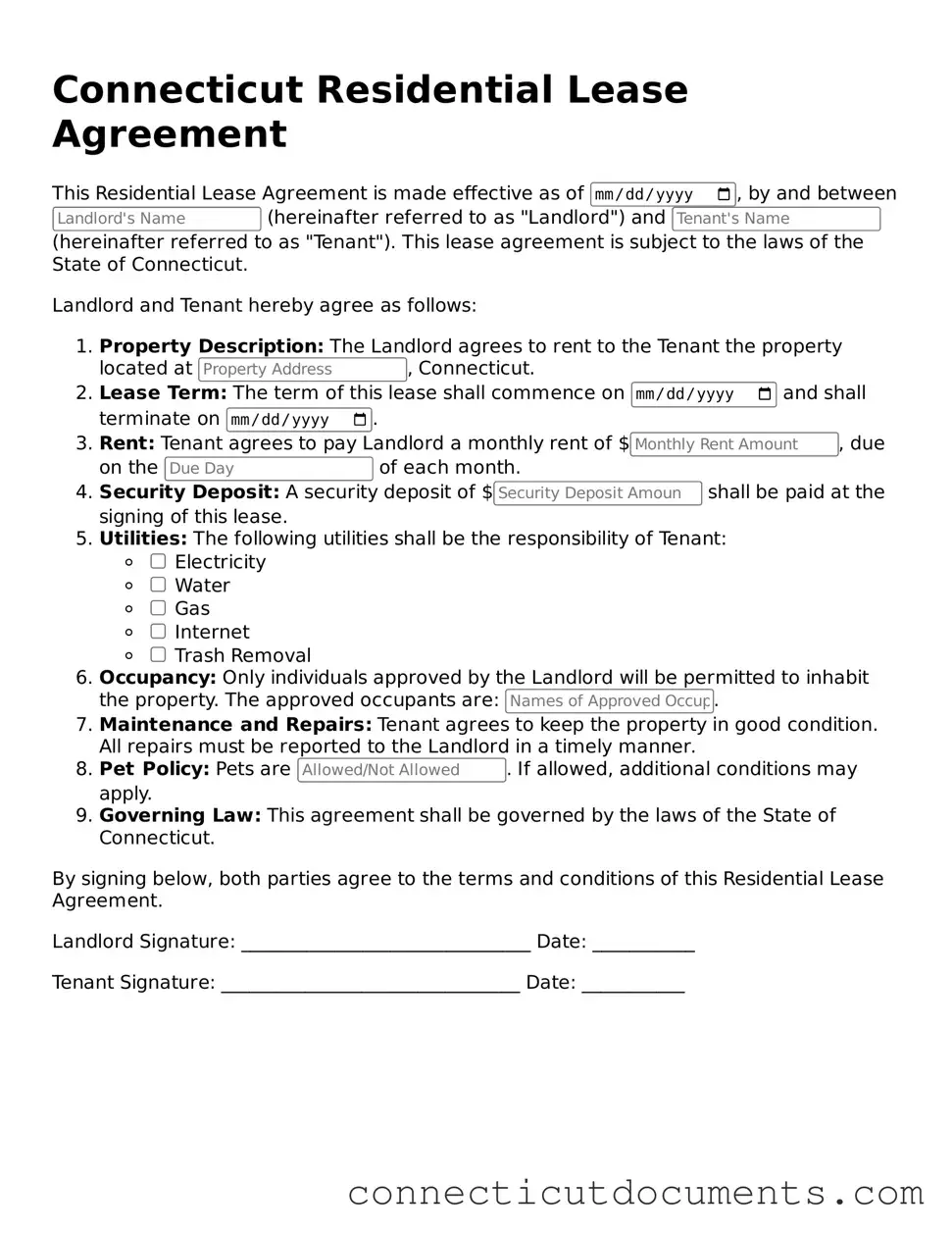The Connecticut Residential Lease Agreement is similar to a Rental Agreement, which is often used interchangeably with a lease. While both documents outline the terms under which a tenant can occupy a property, a Rental Agreement typically covers a shorter duration, such as month-to-month arrangements. In contrast, a Residential Lease usually spans a longer term, often one year. Both documents detail rental amounts, security deposits, and responsibilities of both parties, ensuring clarity in the landlord-tenant relationship.
Another document akin to the Residential Lease Agreement is the Commercial Lease Agreement. This type of lease is designed for business premises rather than residential spaces. While both agreements stipulate rental terms and conditions, a Commercial Lease often includes additional clauses related to business operations, zoning laws, and liability insurance. The complexity of commercial leasing reflects the unique needs of businesses, making it distinct yet similar in its foundational purpose of defining occupancy rights.
The Sublease Agreement shares similarities with the Residential Lease Agreement as it allows a tenant to rent out their leased property to another party. This document outlines the terms under which the subtenant can occupy the space, including rent, duration, and responsibilities. Like a lease, it requires the consent of the original landlord and ensures that all parties understand their rights and obligations, maintaining the integrity of the original lease agreement.
A Roommate Agreement is another document that aligns with the Residential Lease Agreement. While it may not be legally binding in the same way, it serves to clarify the expectations between roommates sharing a rental property. This agreement can cover rent division, shared responsibilities, and rules for common areas. By outlining these details, it helps prevent conflicts and ensures a harmonious living situation, similar to how a lease establishes terms for tenant and landlord interactions.
The Lease Option Agreement is also comparable to the Residential Lease Agreement. This document grants tenants the option to purchase the property at a later date, typically during or at the end of the lease term. It combines elements of leasing and buying, providing tenants with flexibility and potential investment opportunities. Both agreements detail the rental terms, but the Lease Option introduces a unique aspect of future ownership, making it a hybrid between a lease and a purchase agreement.
Understanding the nuances of various rental agreements is essential for both tenants and landlords. The Connecticut Residential Lease Agreement, for instance, is pivotal in establishing clear terms for occupancy. For those looking for a solid format to begin their leasing process, you might consider the NY PDF Forms that provide comprehensive templates to guide you through each step of the leasing journey.
A Tenancy at Will Agreement resembles the Residential Lease Agreement in that it establishes a rental arrangement, but it does so without a fixed term. This type of agreement allows either party to terminate the arrangement with proper notice. While it provides flexibility for both landlords and tenants, it lacks the stability of a traditional lease. However, it still outlines essential terms like rent and responsibilities, ensuring both parties are aware of their obligations.
The Commercial Sublease Agreement mirrors the structure of a Residential Sublease Agreement but is tailored for businesses. It allows a tenant to sublet their commercial space, detailing the terms under which the subtenant can operate. Both agreements require the original landlord's approval and ensure that all parties are aware of their rights. The similarities lie in the fundamental purpose of defining occupancy, though the context and legal implications differ due to the commercial nature.
A Lease Purchase Agreement is similar to a Lease Option Agreement but differs slightly in its commitment. This document obligates the tenant to purchase the property at the end of the lease term. It combines leasing and buying elements, making it a more definitive agreement than a Lease Option. Both agreements require clear communication of terms, but the Lease Purchase Agreement provides a stronger commitment to eventual ownership.
The Month-to-Month Lease Agreement is another document that parallels the Residential Lease Agreement. This type of lease operates on a monthly basis without a long-term commitment, allowing tenants and landlords flexibility. While it covers similar terms regarding rent and responsibilities, it typically requires shorter notice periods for termination. This adaptability makes it suitable for individuals who may not want to commit to a longer lease.
Lastly, the Lease Termination Agreement is akin to the Residential Lease Agreement in that it addresses the end of a rental relationship. This document outlines the terms under which a lease can be terminated, whether by mutual agreement or due to specific circumstances. It ensures that both parties understand their rights and responsibilities upon termination, similar to how a lease sets expectations for the duration of occupancy.
